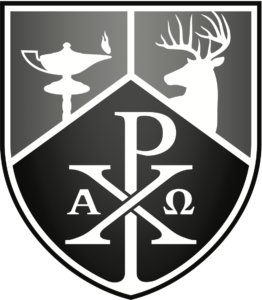
THE SHIELD
The logo for Wittenberg Academy encapsulates what we believe and teach. It is in the shape of a shield, called an escutcheon, which is traditional of medieval coats of arms. Everything contained on a coat of arms has significance—from the colors and patterns to the spatial arrangement. The shield is of course a defensive object in battle, an image that Martin Luther evoked for Christian warfare when he penned the hymn, “A mighty fortress is our God; a trusty shield and weapon.” The shield is divided into three compartments, representing the Holy Trinity, and is rendered in the school colors, black and white. Black signifies wisdom, constancy, and resistance; white signifies truth and purity.
THE LAMP
The upper left corner of the logo contains a lamp on a stand. Light has always been associated with knowledge, and for centuries a lighted oil lamp has been used as a symbol for academic learning. For Christians, the lamp takes on additional significance as a metaphor for the gospel. Most notably, Psalm 119:105 says, “Your word is a lamp to my feet and a light to my path.” Luther says of this Word in Psalm 119:105, “It guides the feet and the heart, and faith does not require understanding… Thus faith does not enlighten the understanding, indeed, it blinds it, but rather the heart. Faith leads it where it will be saved, and it does so through the hearing of the Word” (AE 11:485). In Matthew 5:15-16 Jesus said, “Nor do they light a lamp and put it under a basket, but on a lampstand, and it gives light to all who are in the house. Let your light so shine before men, that they may see your good works and glorify your Father in heaven.”
THE STAG
The upper right corner of the logo contains an adult, male deer called a stag. This animal is alert, graceful, and strong. The stag is an appropriate image for our school since it appears both in early Christian reflection on Scripture and in secular writings on the natural world. The Scriptural source for the image is Psalm 42:1—”As a deer pants for flowing streams, so pants my soul for you, O God.” The naturalists of the ancient world state that the stag was often found alongside water. This was because it either had to slake its thirst from having swallowed poisonous snakes, or it used water from its nostrils to force such snakes out from their crags. Thus, water was used to assault the serpent or remedy its poison. The connection was easily made to baptism and to the pictorial art that adorned baptisteries. Medieval Latin bestiaries, following the Greek Physiologus, continued telling the tale of the stag, along with other fantastic creatures like the phoenix and the pelican. These stories were often paired with dramatic pictures and always included a moral connected to the symbolism of the animal.
THE CHI-RHO
The lower third of the logo is occupied by a large chi-rho. The chi-rho is an early symbol for Christ, composed of the first two letters of ΧΡΙΣΤΟΣ (“Christ” in Greek). Its usage as a christogram dates to the second century, and possibly earlier. On either side of the chi-rho are the Greek letters alpha (A) and omega (Ω), the first and last letters of the Greek alphabet. In Revelation 22:13, Jesus said, “I am the Alpha and the Omega, the first and the last, the beginning and the end.” Alpha and omega were often paired with the chi-rho in early Christian depictions. The white chi-rho bleeds into the white border of the shield, which flows into the lamp and the stag. Every aspect of Wittenberg Academy flows from Christ and his Word.

THE SEAL
The school seal contains an iteration of the logo, but with some additions. The olive branches symbolize peace. In the book of Genesis, a dove returns to the ark with an olive branch in its beak, which “announced to the world the assuagement of divine wrath” (Tertullian). Olive branches also symbolized peace or victory in ancient Greece and Rome. Wittenberg Academy was founded in 2012, which is signified by the Roman numerals above the shield. Below the shield is the school’s motto written in Latin on a scroll: “Docendi sunt christiani.” This translates into English as “Christians should be taught.” This summarizes the mission of Wittenberg Academy, and also alludes to our Lutheran heritage. Nine of Luther’s 95 theses begin with “Docendi sunt christiani…”
